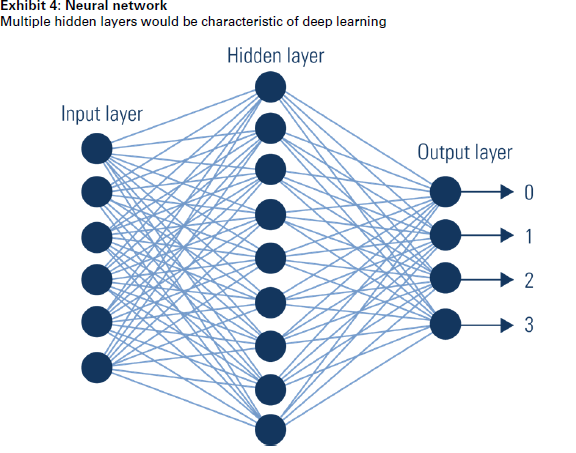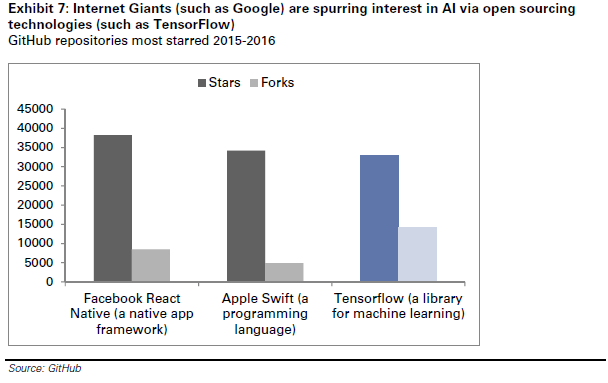“Artificial Intelligence.” More and more often we hear these words today and don’t even realize that this term has slowly penetrated from the plot of sci-fi movies to our real life. Artificial intelligence (AI) is considered the topmost technology of the 21st century. The newest innovations and advances in the information era have combined machine learning with powerful computing and constantly expanding data pool and made the AI available for companies across many industries. These changes gave the great potential to open new markets and disrupt the existing ones significantly. How will artificial intelligence influence our everyday life and will it be able to increase productivity? What are the “real-world” use cases of AI and which challenges remain the main barriers to AI growth? Let’s find answers to these questions in our review.
What is AI? Main Industries of Artificial Intelligence Development.
As one of the newest technologies of our era, artificial intelligence is a result of a great leap from the computers where the process is based on humans telling them how to act all the way to a process where computers learn and improve on processes on their own. Such a breakthrough has caused a significant impact on many industries and changed their usual work forever. One of the exciting aspects of artificial intelligence is the abundance of “real-world” use cases. Apple’s Siri, Amazon’s Alexa, and Google’s photo recognition had become so familiar that we didn’t realise the moment when they penetrated our lives. Deep learning and natural language processing are still improving, creating not only “tech for tech,” but the competitive advantage and value devoted to moving our world forward.
Considering the AI’s influence on industries several examples can be provided.
* Healthcare industry. In healthcare, recently developed image recognition technology can significantly improve the accuracy of a cancer diagnosis. Lots of IoT in Healthcare benefits from AI as well;
* Agriculture industry. Deep learning technologies in agriculture can be used by farmers and seed producers to enhance crop yields;
* Pharmaceutical sector. Being used in pharmaceuticals, deep learning technologies can improve drug discovery;
* Energetic industry. By using AI technologies, in energy, exploration effectiveness is significantly enhanced as well as an increase in equipment availability;
* Financial sector. By opening up new data sets in financial services, analysis becomes faster than it was previously possible. Costs are being lowered.
These are only several examples of AI use cases, but they are already impressive. Taking into account, that AI is in the very early stages of development, the great wave of innovations in every industry can be expected. Artificial intelligence is a breakthrough for the global economy and a powerful driver behind great productivity growth worldwide.
It is evident that AI technologies are going to change the world and are the huge step forward for all the industries they penetrated, but how exactly is Artificial Intelligence defined? AI is a combination of science and engineering to create intelligent machines and computer programs that are able of learning and problem-solving in a way that usually requires human intelligence. AI technologies include visual perception and pattern recognition, natural language processing and translation, and decision making. These are
the main constituents for today, but their number and complexity is rapidly expanding and improving. Among the two major branches of AI are machine learning and deep learning.
1. Machine learning includes algorithms that learn datasets (examples and experience) instead of relying on the predefined rules. In simple words, instead of a developer telling the program how to distinguish strawberry and raspberry, an algorithm is trained (is fed data) and learned HOW to distinguish a strawberry and a raspberry.
2. Deep learning is a branch of machine learning and is considered to be one of the key drivers of AI technologies. In the traditional deep learning approach, humans design attributes that may be predictive (the inputs). In the case of unsupervised deep learning, the essential features are not predefined by humans and are learned and created by the algorithm.

Looking around and evaluating the extent AI has already impacted our lives we should mention:
- Online search. Not so long ago, Google stated that it had begun to send a significant number of its searches to RankBrain (an artificial intelligence system), putting it in one row with the links and content and making one of the three most significant signals in the search algorithm.
- Recommendation engines. Today, AI is widely used by such giants as Netflix, Amazon, and Pandora to determine which movies and products recommend and which songs to play. Recently, Amazon has started using DESTINY (Deep Scalable Sparse Tensor Network Engine) to produce product recommendations.
- Facial recognition. Both Google and Facebook widely use the technology allowing to identify the faces in photos with almost 100{3fbfd6f1e6b19884051837dbbbebf333964dd5fac151615ffbd47b80e5ecc87a} accuracy. Moreover, Apple is going to buy Emotient, the recent startup enabling to determine the emotional state of people by reading and analyzing facial expressions.
Countless other examples can be added here, such as Apple’s Siri, weather prediction, credit, and insurance risk scoring, etc.

Artificial Intelligence Around Us. Main Drivers and Use Cases of AI Today
There are always key drivers for every value creation. What about AI? Profit pool creation related to artificial intelligence can be analysed by four main drivers: talent, data, infrastructure, and silicon. Let’s consider each of them separately.
- Talent. Everything is impossible without talent, and AI is not an exception. Artificial intelligence and deep learning is not an easy undergoing. AI talent is in high demand, and a problem of talent shortage remains.
- Data. Data is the critical input for artificial intelligence. Here the simple rule – the larger data sets are, the better will be learning effectiveness. An excellent example of this is provided by the researchers from the Department of Radiology at Massachusetts General Hospital and Harvard Medical School. They used the convolutional neural network to identify CT images. Researchers evaluated the accuracy of the system based on training data size. They noted that the larger the training size, the higher was the accuracy.

- Infrastructure. Both infrastructure and hardware are necessary for AI work. Infrastructure is expected to become commoditized rapidly, and there are two reasons for such predictions:
- Cloud computing vendors are well positioned to extend their offerings into AI infrastructure;
- Open source (TensorFlow, Caffe, Spark, etc.) has become the primary driver of software innovation in AI.
- Silicon. The repurposing of GPUs for deep learning has become a key driver for the current AI. Within the AI/ML ecosystem the performance of the neural network is determined by two primary applications, each of that requires a different resource setup. The first application is the construction and use of a training algorithm. It uses data set to find correlations and create a model which will be able to determine the probability of output, given a new output. This training requires many resources, and its modern variation is done on GPU powered systems.
We have already mentioned that AI has penetrated many industries. How has it changed them? What are the primary use cases for AI use nowadays? Let’s evaluate the AI effectiveness on examples of the agriculture, financial services, and healthcare industries.
Agriculture. In the agriculture industry, artificial intelligence using has a great potential to significantly increase crop yields at the same time decreasing fertilizer and irrigation costs. In addition to this, AI technologies can assist in the early detection of crop and livestock diseases and lower labor costs for post-harvest sortation. All this will significantly improve the quality of produce and protein that comes to the world market. Also, data sets obtained by using various sensors for gathering soil, weather, aerial/satellite imagery, and auditory data, and analyzed by machine learning, will contribute making right decisions regarding planting times, fertilization, irrigation, and livestock care.
All this together will lead to a significant increase in land, equipment, and human productivity across the whole agriculture industry.

Financial services. Both AI and machine learning have great potential in the financial services industry. Presence of the robust, rich datasets informing about the expediency of investment decisions as well as about credit risks, is an excellent environment for boosting data efficiencies in the financial sector. Machine learning technologies that can use pattern recognition in a fraction of the time of a human-driven equivalent provides all investors with the excellent opportunity for analysis of unique data to maximally accurately evaluate expediency of investment decisions. In addition to this, for lending institutions, AI/ML can help to reduce the credit risks by identifying accounts at risk and making credit line reductions that could reduce loan loss reserves for these institutions.
Healthcare. In the healthcare industry, AI can not only improve the accuracy of a cancer diagnosis by using image recognition technology, but also can have broad application in drug discovery, patient monitoring, and treatment optimization. In the drug discovery sector, machine learning processes can significantly increase the probability of success for medicines reaching late-stage trials. AI/ML implementation can optimize the decisions about selection criteria length, and size of the studies.
In addition to this, companies like Deep Genomics that use ML for identifying diseases at the genome level will get an opportunity to deliver more targeted and effective treatment.
Conclusion and Highlights
Artificial intelligence has already changed a lot in the most-significant industries of our life and isn’t going to stop. The newest innovations in machine learning and deep learning are aimed at disrupting the current state of our life. What can we conclude about the AI state?
- AI is the topmost technology of the 21st century
- The perspectives of AI and ML growth and development are endless
- AI technologies have a high potential to improve agriculture, healthcare, energetic, financial, and pharmaceuticals industries
- Talent shortage problem is among the crucial ones in the world of artificial intelligence technologies
- World famous companies such as Google, Amazon, and Apple have already started investing in AI technologies
- “Real-world” use cases of AI are already numerous, and we expected their number to increase
The artificial intelligence development is rapid and impressive. However, there are still many challenges on its way and barriers to its adoption. Such global breakthroughs require time and lots of effort to develop. In the nearest future a wave of innovations will follow, creating new winners and losers in every industry which will change our lives forever.
Recent Comments